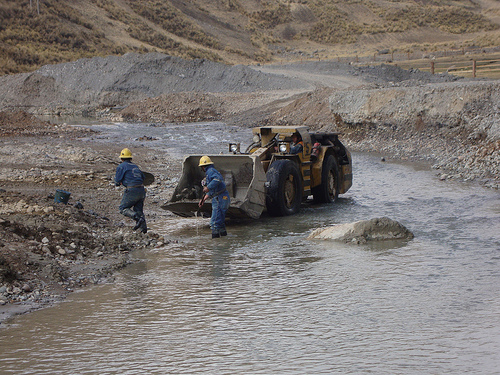Page added on March 1, 2012
Dwindling Resources Trigger Global Land Rush

A global scramble for land and mineral resources fuelled by billions of investment dollars is threatening the last remaining wilderness and critical ecosystems, destroying communities and contaminating huge volumes of fresh water, warned environmental groups in London Wednesday.
No national park, delicate ecosystem or community is off limits in the voracious hunt for valuable metals, minerals and fossil fuels, said the Gaia Foundation’s report, “Opening Pandora’s Box“. The intensity of the hunt and exploitation is building to a fever pitch despite the fact the Earth is already overheated and humanity is using more than can be sustained, the 56-page report warns.
“We’re calling for a global moratorium on large-scale new mining, extraction and prospecting,” said Teresa Anderson of The Gaia Foundation, an international NGO headquartered in London, UK that works with local communities.
The International Union for Conservation of Nature (IUCN) has recently warned of the threats to World Heritage Sites from planned mining and oil and gas projects. One in four iconic natural areas in Africa is negatively affected, the report notes.
“No matter where you live, land acquisitions for mining, oil or gas are coming,” Anderson told IPS following the report’s launch in London.
The easy-to-get resources are gone. Now the extractive industries, funded by pension funds and commodities speculators, are using new technologies like fracking for natural gas to get at previously unprofitable resources.
At the same time, these industries use far more raw material and have a much larger destructive footprint than in the past. Canada’s tar sands are one example, where two to four tonnes of earth are dug up and a similar amount of fresh water is needed to produce one barrel of oil.
It’s a similar story for copper, requiring 10 times the ore it once did to get the same volume, said Anderson.
“No one is looking at the big picture of all this,” she said.
This is just the latest trend in global land grabbing, said Henk Hobbelink of GRAIN, a small NGO working with small farmers and farming communities. GRAIN first brought the world’s attention to the fact that millions of hectares of land in Africa, Asia and South America were being leased or purchased by foreign investors for food and biofuel production.
GRAIN has now documented more than 400 large land deals totalling nearly 35 million hectares, roughly the size of The Netherlands.
Land grabs for mining and fossil fuels are part of a larger attack on land, territories and resources, Hobbelink told IPS from London.
“It is driven by foreign capital and speculators to gain control over land,” he said.
This is “turning communities into refugees on their own land”. And people have been been targeted and killed if they resist, he said.
“This new wave of land grabbing is putting profit above people and planet,” said Polly Higgins, a barrister and author of “Eradicating Ecocide”.
States are obligated to “close down the extractive industries that cause risk of loss or injury to life” and can no longer claim they have no knowledge of the damage done, Higgins said in a release.
“The extractive industries have become bigger and much more aggressive,” based on the data collected over the past year for the report, said Anderson.
“Operations like shale gas aren’t in remote areas – they are coming to your backyard,” she added.
Shale gas “fracking” that involves high pressure injection of chemicals underground is already in backyards in the US, Canada, and Australia. The UK, China, South Africa, Poland and other countries are looking to begin commercial operations.
The explosive growth of shale gas fracking is mirrored by other extractive industries. Globally, in just the last 10 years, mining for iron ore has increased 180 percent, cobalt by 165 percent and lithium by 125 percent. China’s mining sector grew 30 percent in just five years. Peru’s mining exports increased by one-third in 2011 alone.
Coal mining has increased by 44 percent in the past 10 years despite international agreement on the need to reduce carbon emissions to avoid dangerous climate change.
“The changes needed to move from fossil fuels aren’t being made,” said Anderson.
Instead, major investments are going into the search for fossil fuels in remote regions like the Arctic and into “extreme energy sources” like shale gas and tar sands that have big environmental impacts.
It also takes enormous amounts of water to extract minerals, metals and fossil fuels. And then there is the staggering amount of waste that results. Canada’s tar sands have 130,000 hectares of tailings ponds full of toxic wastes behind some of the largest earthen dams ever constructed.
Mining companies dump more than 180 million tonnes of hazardous mine waste into rivers, lakes and oceans worldwide every year, according an investigation released Tuesday by two mining reform NGOs .
Mining enough gold for just a single wedding band generates, on average, 20 tonnes of contaminated mine waste.
“Polluting the world’s waters with mine tailings is unconscionable, and the damage it causes is largely irreversible,” said Payal Sampat, international programme director for Washington, DC-based Earthworks.
“Our rivers run red, our houses have become unstable, we have lost fresh drinking water,” said Mark Ekepa, a local landowner in West Papua, Indonesia where millions of tonnes of goldmine waste are dumped by Canada’s Barrick Gold Corporation, the world’s biggest gold company, from its Grasberg mine.
Rising prices, increasing material consumption and a huge flood of investment have triggered this global boom, the report found. Following the 2008 collapse of financial markets, hedge and pension fund investors dramatically increased investments in metal, mineral, oil and gas commodities.
As a direct result, exploration budgets have reached record levels – 18.2 billion dollars in 2011 for non-ferrous metals alone. That’s six times the 1994 budget.
Escalating material consumption underlies all of this, with the average U.S. citizen using an astonishing 22,000 times their weight in minerals, metals and fuels in their lifetime (1,343 metric tonnes). Even switching to “greener” technologies will not reduce this substantially. Major improvements in resource-use efficiency and reuse are needed along with less consumptive lifestyles, the report concludes.
“This report (Opening Pandora’s Box) shows clearly how the game has changed over the last decade: the grabbing of land and resources is penetrating ever more deeply into the body of the Earth,” said Nnimmo Bassey, chair of Friends of the Earth International, in a release.
“The devastating impact being inflicted on ecosystems and communities must be recognised as international crimes and punished accordingly,” Bassey said.
2 Comments on "Dwindling Resources Trigger Global Land Rush"


BillT on Fri, 2nd Mar 2012 1:33 am
We are leaving our future generations a hell on earth. The dominant species in 1,000 years will be roaches.
Kenz300 on Fri, 2nd Mar 2012 7:26 pm
Too many people and too few resources. The ever growing population is consuming more and more of the earths resources. This never ending population growth is not sustainable.